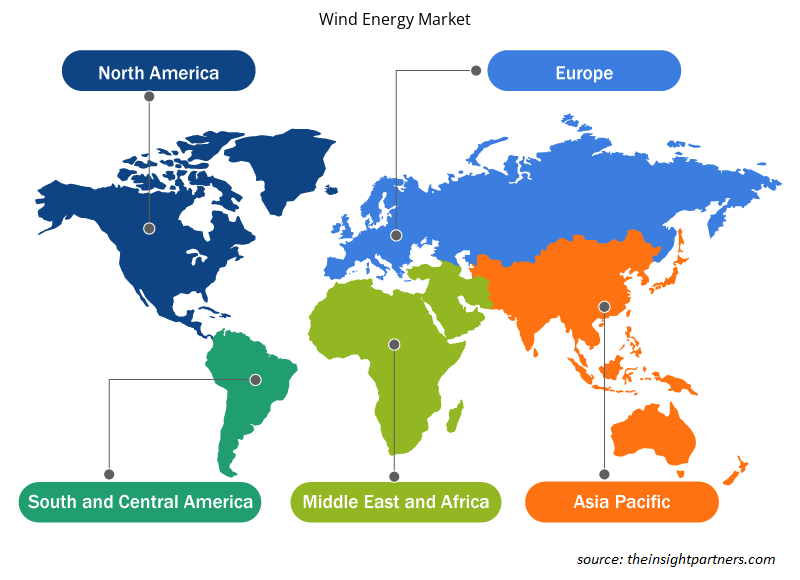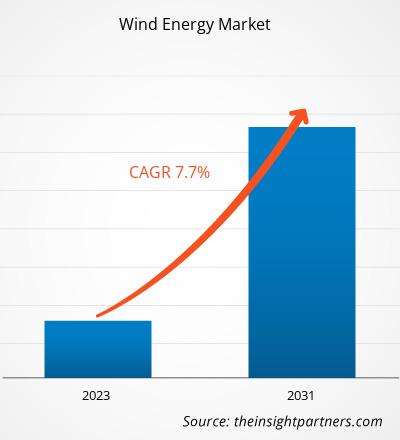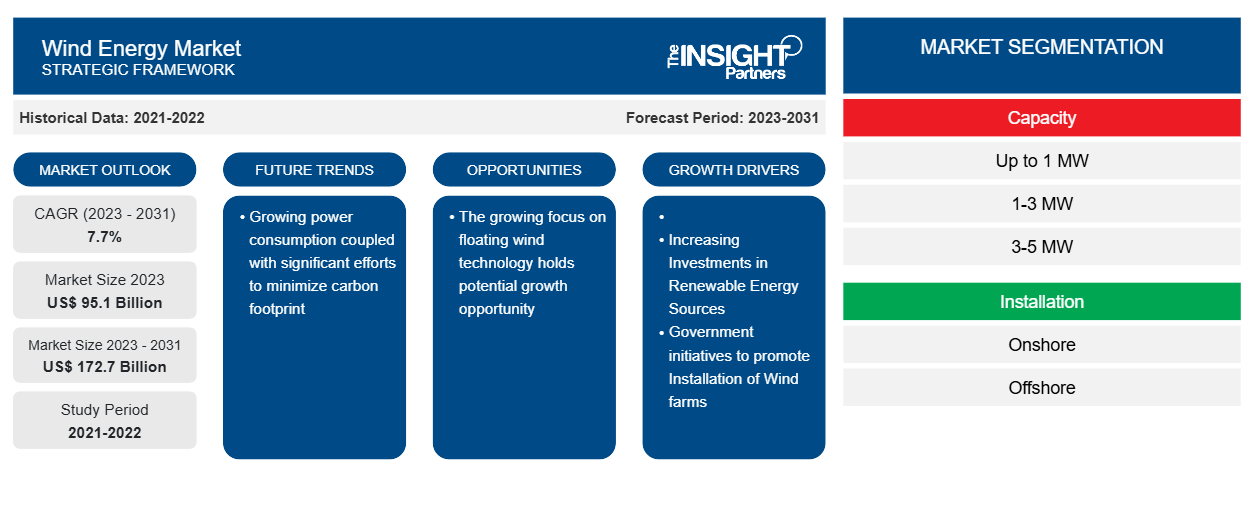Se prevé que el tamaño del mercado de la energía eólica alcance los 172.700 millones de dólares en 2031, frente a los 95.100 millones de dólares en 2023. Se espera que el mercado registre una CAGR del 7,7 % entre 2023 y 2031. El aumento del consumo de energía, junto con los importantes esfuerzos por minimizar las emisiones de carbono, se encuentra entre los factores clave que impulsan el mercado de la energía eólica.
Análisis del mercado de la energía eólica
Se espera que el mercado de la energía eólica experimente un crecimiento considerable durante el período analizado debido al creciente número de proyectos de energía eólica terrestre y marina, en particular en lugares remotos. Además, se espera que las regulaciones gubernamentales para reducir las emisiones de carbono centrándose en la generación de energía a través de fuentes de energía renovables como la eólica, la solar, la geotérmica y otras impulsen el crecimiento del mercado entre 2023 y 2031. Además, se prevé que las iniciativas gubernamentales para la instalación de parques eólicos en todo el mundo impulsen el crecimiento del mercado en los próximos años.
Panorama del mercado de la energía eólica
Con el aumento de la población y la industrialización, la demanda de energía también está aumentando a nivel mundial. El aumento del consumo de energía también impulsó la necesidad de generación de energía renovable en las economías en desarrollo y desarrolladas. Esto ha dado lugar a un impulso de la demanda de infraestructura de energía eólica en todo el mundo. La generación de energía eólica ha ganado un alto nivel de importancia y aceptabilidad en todo el mundo en comparación con otras fuentes de energía renovable. Los avances tecnológicos en el diseño y desarrollo de palas, turbinas , ejes y otros componentes de energía eólica han contribuido a un avance significativo en la adopción de la energía eólica y en la consecución de la máxima potencia del viento disponible. Según la Agencia Internacional de Energías Renovables (IRENA), la capacidad eólica instalada mundial alcanzó los 1.017 GW a finales de 2023, frente a los 825 GW de 2021. Por tanto, se espera que dicho aumento de la capacidad eólica instalada aumente en los próximos años, debido a las ventajas de la energía eólica y a las políticas favorables, los incentivos y las devoluciones fiscales.
Personalice este informe según sus necesidades
Obtendrá personalización en cualquier informe, sin cargo, incluidas partes de este informe o análisis a nivel de país, paquete de datos de Excel, así como también grandes ofertas y descuentos para empresas emergentes y universidades.
-
Obtenga las principales tendencias clave del mercado de este informe.Esta muestra GRATUITA incluirá análisis de datos, desde tendencias del mercado hasta estimaciones y pronósticos.
Factores impulsores y oportunidades del mercado de la energía eólica
Se espera que las iniciativas gubernamentales para promover la instalación de parques eólicos sean el principal impulsor del mercado de la energía eólica.
Se prevé que el aumento del apoyo de los distintos gobiernos de distintos países en términos de políticas, subsidios e inversiones para aumentar la instalación de proyectos de energía eólica impulse el crecimiento del mercado de la energía eólica durante el período analizado. El gobierno indio está comprometido con la promoción de plantas de energía eólica en el país a través de la financiación del sector privado, proporcionando diversos incentivos fiscales y financieros, como beneficios de depreciación acelerada y exenciones de derechos de aduana o impuestos concesionales sobre ciertos componentes de los generadores de electricidad eólica. Por ejemplo, Alemania está planeando presentar un proyecto de ley para acelerar la expansión de la energía eólica. La nueva ley aplicará objetivos de área vinculantes para la expansión de la energía eólica terrestre en los estados federales. En abril de 2022, Alemania planeó implementar objetivos de energía eólica marina de más de 10 GW por año a partir de 2025 con la ayuda de un paquete histórico llamado Paquete de Pascua, que es la serie de cambios más profundos en la política energética alemana. Con la ayuda de estas iniciativas gubernamentales, el 80% de la demanda de electricidad de Alemania estará cubierta por electricidad de fuentes de energía renovables para 2030.
El creciente interés por la tecnología eólica flotante ofrece oportunidades potenciales de crecimiento.
La tecnología eólica flotante es la turbina eólica marina montada sobre una estructura flotante en el mar que garantiza que la turbina genere electricidad en las profundidades del agua. La tecnología eólica flotante o marina es altamente eficiente en condiciones ambientales adversas y, por lo tanto, capaz de producir enormes cantidades de energía. Esta tecnología eólica flotante se ha adoptado globalmente en varios países, como China, Alemania, Japón, el Reino Unido, Francia, Bélgica y Dinamarca. Las perspectivas de crecimiento en la adopción de la tecnología eólica flotante se atribuyen principalmente a un aumento en el avance de la tecnología, las ventajas asociadas y las soluciones llave en mano proporcionadas por varios proveedores de servicios. La creciente conciencia de la necesidad de alcanzar los objetivos de energía limpia por parte de varios países está impulsando la demanda de energía eólica marina flotante, lo que plantea una oportunidad potencial para el crecimiento del mercado de la energía eólica.
El informe del Centro de Excelencia de Energía Eólica Marina Flotante ha identificado a 22 países que están más preparados para convertirse en actores importantes en la naciente tecnología de energía renovable . En enero de 2022, el gobierno del Reino Unido anunció 11 proyectos de energía renovable que recibirán hasta 959,23 millones de dólares cada uno, al tiempo que propone 2.970 millones de dólares para impulsar la energía renovable generada en el Reino Unido. Se prevé que esta inversión en tecnología eólica marina o flotante en todo el mundo impulse el crecimiento del mercado en los próximos años.
Análisis de segmentación del informe del mercado de energía eólica
Los segmentos clave que contribuyeron a la derivación del análisis del mercado de energía eólica son la capacidad y la instalación.
- En función de la capacidad, el mercado de energía eólica se ha dividido en hasta 1 MW, 1-3 MW, 3-5 MW y más de 5 MW. El segmento de 1-3 MW tuvo una mayor participación de mercado en 2023.
- En función de la instalación, el mercado de la energía eólica se ha dividido en terrestre y marino. El segmento terrestre tuvo una mayor participación de mercado en 2023.
Análisis de la cuota de mercado de la energía eólica por geografía
El alcance geográfico del informe del mercado de energía eólica se divide principalmente en cinco regiones: América del Norte, Europa, Asia Pacífico, Medio Oriente y África y América del Sur.
La región de Asia Pacífico dominará el mercado de la energía eólica en 2023. La región de Asia Pacífico incluye Australia, China, Japón, India, Corea del Sur y el resto de Asia Pacífico. El crecimiento de la industria de la energía eólica en la región de Asia Pacífico se atribuye principalmente al aumento de la inversión en la industria renovable, el aumento exponencial de la industrialización y la urbanización, la capacidad de generación de energía eólica, los nuevos proyectos de electrificación y las iniciativas de fortalecimiento de la red. Según los objetivos de energía renovable de IRENA y de China, el país podría añadir más de 90 GW de nueva capacidad de energía eólica marina entre 2021 y 2030. El sector de la energía eólica de la región de Asia Pacífico está preparado para una rápida expansión. Podría representar casi una cuarta parte de la combinación de capacidad energética de la zona en esta década, según un nuevo estudio, ya que la alta demanda interna de energía eólica marina convierte a China continental en el mercado más grande del mundo para 2030.
Perspectivas regionales del mercado de energía eólica
Los analistas de Insight Partners explicaron en detalle las tendencias y los factores regionales que influyen en el mercado de energía eólica durante el período de pronóstico. Esta sección también analiza los segmentos y la geografía del mercado de energía eólica en América del Norte, Europa, Asia Pacífico, Oriente Medio y África, y América del Sur y Central.

- Obtenga los datos regionales específicos para el mercado de energía eólica
Alcance del informe sobre el mercado de energía eólica
| Atributo del informe | Detalles |
|---|---|
| Tamaño del mercado en 2023 | US$ 95,1 mil millones |
| Tamaño del mercado en 2031 | US$ 172,7 mil millones |
| CAGR global (2023 - 2031) | 7,7% |
| Datos históricos | 2021-2022 |
| Período de pronóstico | 2023-2031 |
| Segmentos cubiertos |
Por capacidad
|
| Regiones y países cubiertos |
América del norte
|
| Líderes del mercado y perfiles de empresas clave |
|
Densidad de actores del mercado de energía eólica: comprensión de su impacto en la dinámica empresarial
El mercado de la energía eólica está creciendo rápidamente, impulsado por la creciente demanda de los usuarios finales debido a factores como la evolución de las preferencias de los consumidores, los avances tecnológicos y una mayor conciencia de los beneficios del producto. A medida que aumenta la demanda, las empresas amplían sus ofertas, innovan para satisfacer las necesidades de los consumidores y aprovechan las tendencias emergentes, lo que impulsa aún más el crecimiento del mercado.
La densidad de actores del mercado se refiere a la distribución de las empresas o firmas que operan dentro de un mercado o industria en particular. Indica cuántos competidores (actores del mercado) están presentes en un espacio de mercado determinado en relación con su tamaño o valor total de mercado.
Las principales empresas que operan en el mercado de energía eólica son:
- Sistemas eólicos Vestas A/S
- Energía Siemens
- Viento dorado
- Grupo ENVISION
- Energía renovable de GE
- Energía inteligente Mingyang
Descargo de responsabilidad : Las empresas enumeradas anteriormente no están clasificadas en ningún orden particular.

- Obtenga una descripción general de los principales actores clave del mercado de energía eólica
Noticias y desarrollos recientes del mercado de energía eólica
El mercado de la energía eólica se evalúa mediante la recopilación de datos cualitativos y cuantitativos a partir de investigaciones primarias y secundarias, que incluyen publicaciones corporativas importantes, datos de asociaciones y bases de datos. A continuación, se incluye una lista de los avances en el mercado de la energía eólica y las estrategias:
- En junio de 2022, Vestas se asoció con PEC Energia para construir un parque eólico de 86 MW en Brasil. Con este proyecto, Vestas superó el hito de 7 GW de pedidos recibidos en Brasil desde 2018.
- En septiembre de 2021, Goldwind, un fabricante de turbinas eólicas, conectó su unidad de prueba terrestre de 5 megavatios a la red eléctrica mientras se prepara para comenzar las entregas en 2022. La turbina eólica inteligente terrestre 5S de accionamiento directo con imanes permanentes (PMDD) de Goldwind posee un diámetro de rotor de 165 m y alturas de buje que van desde 100 a 130 metros.
Informe sobre el mercado de energía eólica: cobertura y resultados
El informe “Tamaño y pronóstico del mercado de energía eólica (2021-2031)” proporciona un análisis detallado del mercado de energía eólica que cubre las siguientes áreas:
- Tamaño del mercado y pronóstico a nivel global, regional y de país para todos los segmentos clave del mercado cubiertos bajo el alcance
- Dinámica del mercado, como impulsores, restricciones y oportunidades clave
- Principales tendencias futuras
- Análisis detallado de las cinco fuerzas de Porter
- Análisis del mercado global y regional que cubre las tendencias clave del mercado, los principales actores, las regulaciones y los desarrollos recientes del mercado.
- Análisis del panorama de la industria y de la competencia que abarca la concentración del mercado, el análisis de mapas de calor, los actores destacados y los desarrollos recientes
- Perfiles de empresas detallados con análisis FODA
- Análisis histórico (2 años), año base, pronóstico (7 años) con CAGR
- Análisis PEST y FODA
- Tamaño del mercado, valor/volumen: global, regional y nacional
- Industria y panorama competitivo
- Conjunto de datos de Excel
Informes recientes
Informes relacionados
Testimonios
Razón para comprar
- Toma de decisiones informada
- Comprensión de la dinámica del mercado
- Análisis competitivo
- Información sobre clientes
- Pronósticos del mercado
- Mitigación de riesgos
- Planificación estratégica
- Justificación de la inversión
- Identificación de mercados emergentes
- Mejora de las estrategias de marketing
- Impulso de la eficiencia operativa
- Alineación con las tendencias regulatorias























 Obtenga una muestra gratuita para - Mercado de energía eólica
Obtenga una muestra gratuita para - Mercado de energía eólica